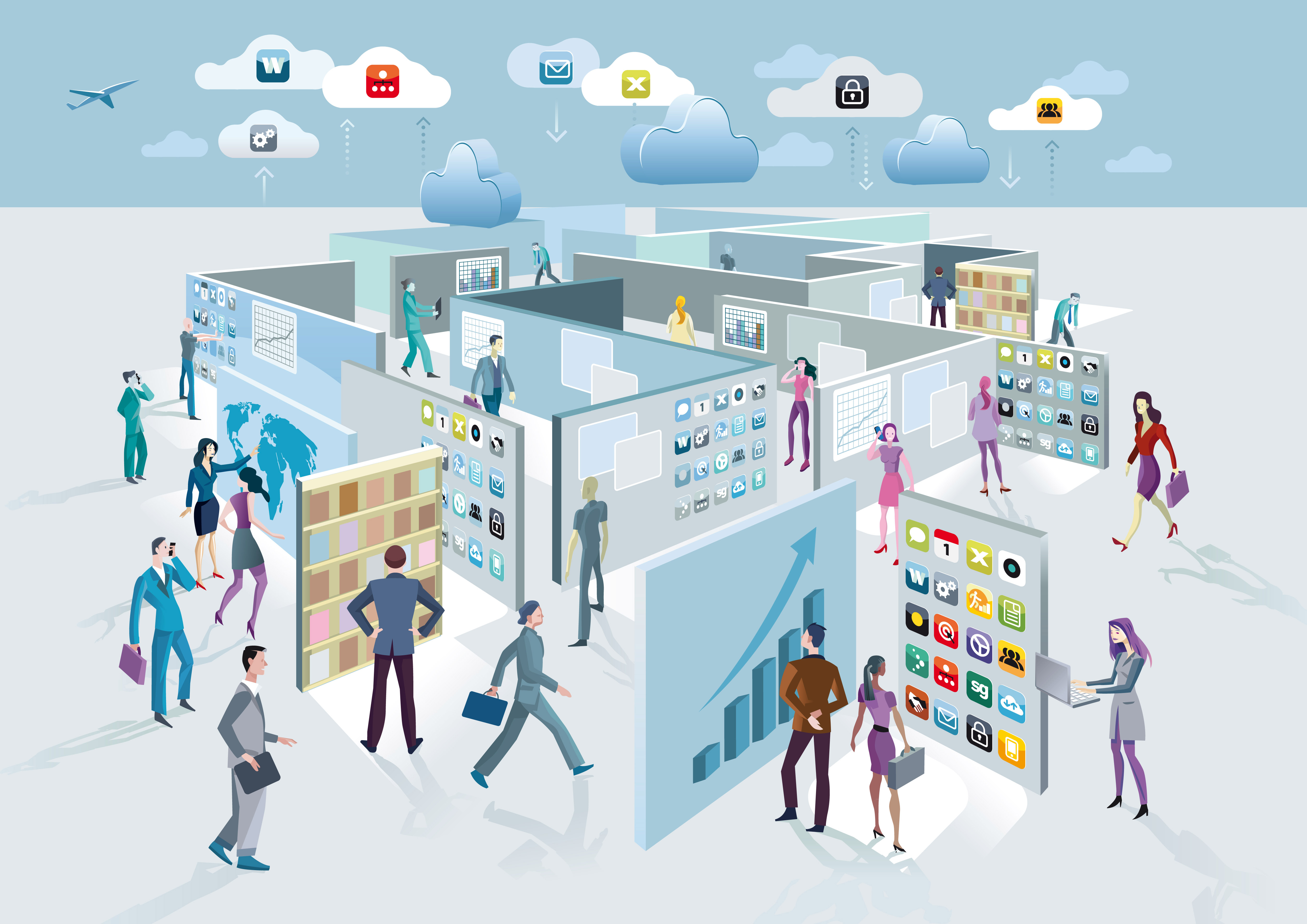Facebook and Work: An Unlikely Partnership
05 Mar, 2015 |
Believe it or not, there used to be a time when Facebook was used as a productivity tool.
Those were simpler times.
Back when Facebook originally launched, it was designed only for college students, requiring them to submit a school email in order to create an account. In fact, it’s a good age indicator if someone you know logs into Facebook with an email ending with “.edu”; chances are they were in college sometime during 2004-2006.
Long before there were timelines, sponsored posts, and candy crush invites, students used Facebook primarily to collaborate with other students in and out of the classroom. It was common for classmates working together in a group project to create their own Facebook group as a communication hub throughout the duration of the project. If users wanted to distract themselves a few minutes with a bit of gossip, myspace.com was the place for that, as Facebook only distracted you with the occasional “Poke” from a friend or a crush.
Of course nowadays, Facebook and Productivity have become completely disassociated with each other.
When Facebook decided to shift their efforts on creating streams of revenue, that’s when it bacame the hotbed of distraction that it is today. Love it or hate it, Facebook has become such a widespread and massively accepted social media giant, as well as the number one most banned domain in corporate internet networks.
With its reputation as a time waster, it came as a bit of a surprise when Facebook announced the unveiling of a new product designed specifically for enterprises and large organizations. The new app, available online and in the iTunes and Android stores is called “Facebook at Work” and it is currently in the beta stage.
Social technology continues to be a rapidly evolving part of the modern workplace. There is an increasing amount of online software already available for enterprises that help keep track of work projects, timelines, team members, and deadlines.
A few standouts
SLACK– An online and mobile app that tries to streamline all your workplace communication in one place.
BASECAMP-, a simple to use application that breaks down projects of any size into to-do lists.
Websites such as wtdiw.com also provide a wide array of online solutions aimed to facilitate organizational communication, shift scheduling, and labor planning.
Notably, one of the most widely used apps is Asana, a task management application which was created by Dustin Moskovitz, one of the original founders of Facebook who left the company in 2008 to start this new venture.
Facebook at Work
Facebook faces a different competition field with this launch.
From the get go, they tackle the stigma associated with Facebook by allowing users to create accounts that are separate from their personal accounts, creating networks only within the larger framework of their own organizations.
A subtle change in Facebook at Work is in the color palette. White is the predominant color of the application interface and it serves to differentiate it from the well known blue that is a staple in Facebook’s social media interface, most likely to help keep both networks separate from each other during work hours (in other words, so your boss can know which “Facebook” you are using).
Despite it’s size, Facebook faces many obstacles in the competitive field of enterprise communication tools. The failure of google plus taught us that domination in one market does not guarantee success in another; no matter how much you shove it into your customer’s face.
There is also a growing amount of trust issues with consumers and Facebook when it comes to data privacy. Corporations are right to be concerned about their internal communication and data being compromised in any way. Facebook’s damage control efforts to protect their reputation will become even more essential if they expect businesses to trust them with their data.
Despite these obstacles, Facebook deserves the benefit of the doubt when predicting the success of this new app not only for their past success but also because “Facebook at Work” seems less like a reinvention and more like a return to their roots.
The Importance of Healthy Workplace Culture
26 Feb, 2015 |
An Intangible Perk
What does it mean’s to have a great corporate culture? Now more than ever, work culture is as important as any other benefit that an employer can offer. Defining the components of great organizational culture remains can be elusive because most of these attributes are hard to quantify. Regardless, a brief overview of some of the most reputable enterprises shows some common patterns.
Employee Benefits and Pay- Perhaps the most obvious factor connected with popular workplaces is employee compensation. The fast food and retail industries aren’t necessarily associated with high numbers of employee satisfaction yet establishments such as In-N-Out burger and Costco Wholesale repeatedly make the yearly list of best places to work. This has been mainly attributed to employee compensation that goes way above average industry rates.
It’s understandable that businesses would struggle in this area since their goal should always be to create profits. However, though above-average pay rates don’t immediately reap rewards, it certainly paid off for In-N-Out in terms of reputation. In recent fast food work strikes, In-N-Out workers where the only major fast food chain whose employees refused to walk out. President of Planning Carl Van Fleet stated, “High pay rate leads to lower turnover, and that, of course, leads to a more experienced team working in our restaurants. The raises that our associates earn for mastering different positions makes it possible for them to earn more as they gain that experience.”
Work/Life Balance
The recent economic recession has helped create a generation that doesn’t fully entrust their employment security in the hands of a corporation. After witnessing thousands of loyal employees lose their jobs following years of devoted service, younger workers have now placed greater emphasis on personal satisfaction and development rather than relying on a company to take care of them years down the road.
With many workers taking up side-jobs, classes, and hobbies, work/life balance has become even more important. Colgate-Palmolive does a great job at exemplifying what it takes to foster a good balance between life and work. The company offers nearby child-care centers emergency in-home care for dependents, tuition assistance, and financial counseling services for all of their employees. Like In-N-Out, Colgate places high importance on employment retention which seems to create a sense of unity, cohesiveness, and general competence within departments over time.
Hierarchical Mobility
Following the trend of personal empowerment, organizations are slowly breaking down traditional leadership structures for settings that are more open and collaborative. This arrangement allows for workers to have increased access to company executives, facilitating the flow of ideas as opposed to hampering innovation by burying it under numerous layers of hierarchy. This “flat” structure is also designed to identify value from the perspective of the customer. This makes sense for companies such as Apple, whose entire business is the result of a pristine sense of discernment and control of the customer experience. At Apple, all developers and engineers report directly to the CEO.
Not every idea or initiative will gain traction, but when it comes to creating an appealing corporate culture, having available those channels of communication will undoubtedly go a long way.
3 Tips for Creating Healthier Work Environments
19 Feb, 2015 |
A healthy work environment has always been an integral part of having a productive workplace. With the prevalence of mobile devices and the risk of viral social media posts from disgruntled employees, workplace wellness has become an even more important endeavor. All emphasis placed on customer satisfaction should come with awareness that employees are also internal customers who wield a great amount of power to make or break your business’ reputation.
The amenities offered at some of the most sought after companies would seem like an urban legend were it not for actual photos of the nap rooms available to employees at Google,the 5-star Chefs that cater food to employees at Facebook, and testimonials of the $10,000 budget that new hires at Asana are given to design their work space and computer stations. There is no simple formula on how to foster these kind of environments. We are not advising mechanics to install bunkbeds in their shops or to invite Gordon Ramsay to the company picnic, but there are a few strong tips that go a long way towards achieving employee satisfaction
1. Let them own it
If employees are going to be held accountable for their responsibilities, it is imperative that they are given reasonable flexibility to decide how their task are to be carried out. This means that they will make mistakes sometimes, but if given fair control of their work space, process design, and work flow, they will develop a personal stake in the performance of their duties and responsibilities. It may initially seem like a risk but it creates an opportunity for management to place greater emphasis on the process of training and mentorship.
Management will now play an important role in providing ongoing support to the employees they train with the goal of allowing them to flourish in their respective roles.
2. Open feedback loops
Once employees are given ownership of their roles, it’s essential for them to have some access to the decision making process that defines their procedures and protocols. Corporate strategy is meaningless if it loses touch with the realities of the operational forefront. This doesn’t mean that everyone will get a microphone at the next corporate meeting, but it would be wise to have some type of system where employees can submit solutions and suggestions to ongoing challenges. One designated manager would be tasked with reviewing and selecting submissions that would be turned over to the decision makers.
3. Stay Technically Relevant.
Many organizations have employees performing long and tedious tasks in order to avoid the cost of purchasing and implementing more efficient systems. These savings take its toll on employee morale, as nothing is more demoralizing than having to fill tedious paperwork by hand knowing that a modern system would not only reduce the time, but reduce margin of error as well. In this day an age, there are numerous tools that help managers design shift schedules, work invoices, project management tools, and purchase orders. It will benefit your entire work force if they are given the best tools to manage their responsibilities.
—-
Looking for ways to make your workplace environment more efficient? Take a tour of the best scheduling tool on the planet, and get a free 30-day trial (no-risk).
Making Workplace Distractions Work for You
12 Feb, 2015 |
Distractions are an inevitable part of any workplace, wether it be corporate, industrial, or domestic. While not necessarily harmful all by themselves, workplace distractions have a tendency to warp our sense of time and if not controlled, can really cut away at our productivity. The issue is more complex that it might seem for there are many mental mechanism at play that gravitate certain people towards procrastination. Regardless of the internal battles going on, distractions don’t always need to be avoided. There are many ways to manage and even harness some usefulness out of them. Here are just a few:
BE ATTENTIVE
Self-awareness goes a long way when you’re trying to focus on a task or problem. Being aware of your personal patterns of distraction can help you make necessary adjustments to your surroundings that place your most common distractors out of immediate reach. Instead of summoning your will-power to avoid them, its better to eliminate some of them completely. Some experts suggest that we have a limited amount of self-control to exert every day. Your productivity and willpower is better suited to be used during times when you are already in a work grove. Some managers will approach this by blocking certain websites from browsers at work, but there are many online tools that allow you to set personal time limits on sites you visit, without having to block them completely. These filters can be programmed to keep you updated with a timer that tells you how much time is being spent on a particular website on that given day. You can set time limits that are applicable to work hours only while still allowing yourself some wiggle room to browse sites such as Facebook and Reddit for limited amounts of time.
BE DELIBERATE WITH DISTRACTIONS
Now that you’ve placed a time cap on your biggest time-traps, now you can designate time for you to mindlessly indulge in seemingly non-productive activities. There are multiple benefits to stepping away the task at hand every few hours. Wether you’re writing a report, article, or trying to tackle a major problem, taking yourself completely out of the task gives you an opportunity to come back with a new approach later on. It may seem unconventional, but stepping away from something allows your mind to shift gears for a bit. That elusive solution to your problem isn’t going to solve itself, but many “EUREKA” moments tend to occur after a period of brief detachment because perspective has a lot to do with problem solving, and sometimes all thats needed to make a breakthrough is a mere change of perspective.
Pick the RIGHT DISTRACTIONS
An important part of distraction management is deciding what kind of distractions you are going to allow. While browsing social media sites can provide a break from your work, the best kind of break is one that takes you away from you desk completely.
- Go for a walk. Doing some brisk pushups, or any other type of short exercise can get help get your blood flowing, giving your brain some fresh oxygen to as well as a fresh mindset when returning to work.
- Read. Opening up some book for a few minutes can also be a productive escape. Getting lost in a great literary adventure for just a few minutes can do wonders during stressful days.
- Organize. If you’re feeling stuck on a task and can’t figure out what to do next, take some a few minutes to organize your desk or work area. Getting rid of notes and papers you no longer need. Getting rid of unnecessary clutter in your surroundings could lead you right into that pending task that you were forgetting.
Feel free to comment and discuss any particular activities that you find unconventionally helpful!
Looking for the best tool for easily managing your employees’ schedules? Take a tour and get a free trial here.
How to Take Your Company with You
09 Feb, 2015 |
Some businesses are intrinsically mobile, because they have to do with representation, or the clients themselves are far away and working through the Internet is essential to any kind of business taking shape. The type of entrepreneur likely to seek information about creating a mobile office is the one accustomed to a physical office. The good news is that mobile business is becoming the norm and that technology greatly assists this process. Take a look at these tips about how to stay in contact with all the essentials of your business.
Have Multiple Ways to Stay In Contact
The only disadvantage of working remotely is that it is no longer possible to walk through an office building and physically seek out a manager or coworker. Using office telephones to avoid footwork is a strategy that has been employed since businesses could afford their own networks, and few companies prohibit the use of cellphones for company purposes. It is almost essential to have a cellphone in many office buildings; managers will call workers just to summon them up a flight of stairs.
Remote workers should have all their contacts on their cellphone, but should also have email address and voice-over-net accessibility. While not all contacts prefer video calls, many do because it preserves the face-to-face element of business. Many services capable of video calls are also able to share large files, and email services should also be able to transfer large files.
These different capabilities allow two interested parties to stay in touch, but also allow for flexible information sharing. A cellphone can text to an instant messenger and vice versa. Not all cellphones can receive PDF documents, but some cellphones can take photographs and transfer them to a desktop at high speed. Many collaborative projects require specific file formats, so it pays to know in advance what formats a client will accept.
Taking Your Personal Business with You
The other end of mobile office has less to do with communicating with others and being able to stay comfortable and productive while on the road. This means having luggage that is slim enough, yet versatile enough to be able to survive various modes of transpiration. As an example, national flights will only allow for a single large tote without additional charge. While it is always possible to pay for more cargo room, too much is an anchor that prevents travel.
Frugality and improvisation are key. The same jewelry can be reused, and a smart phone can double as a camera and thumb drive. Most areas have overnight dry cleaners, and using their services is better than packing a dozen suits. Food is largely expendable as a travel item.
Tools For Traveling Finances
The World Wide Web is a traveler’s best friend for banking. Not only is it possible to look at account information, but many banks allow access to credit via electronic application. Traveler’s checks can still be beneficial, but are increasingly overshadowed by near universal credit card networks. Using credit as an expense account is an iffy prospect, because this means securing a business loan. Some lenders specialize in high risk merchant account services, while others only offer general accounts with conditional spending terms. High risk merchant account providers will need to stay in touch to be able to go through with all your transactions.
Becoming a mobile business is easy. Whether you’re on your own, or just a satellite of a larger company, you should know the basic tools for making your business more flexible and travel friendly.





